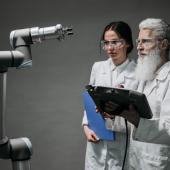Open Innovation and Taming the Competitive Spirit
An interview by David Eldridge, Crane Communications Inc.
Dr Bettina von Stamm set up the Innovation Leadership Forum in 2004, has worked
in the field of innovation for almost 20 years, and has published three books: The Future of Innovation, Managing Innovation Design & Creativity, and The Innovation Wave.
At our Product Design + Innovation conference in May, she gave a thought-provoking presentation based on her work – at the lightning speed demanded by the Pecha Kucha format she took part in.
During a more relaxed interview this month, David Eldridge explored her work in more detail. The words ‘discovery’ and ‘sharing’ come to mind when hearing Dr Bettina von Stamm discuss her work with multinational organisations over the past two decades.
She has made discoveries about impediments to innovation and has witnessed organisations’ learning journey into developing a deeper understanding of innovation.Sharing is something she does with the members* of the Innovation Leadership Forum Networking Group when they meet four times a year, and with postgraduate students on courses around almost the entire globe.
Discovery and sharing both spring from an Open Innovation approach in which collaboration and open mindedness replace secrecy and inflexibility.
She says that in order to truly embrace Open Innovation and benefit from its potential organisations often need to “tame the competitive spirit”. This is tough given that companies – and the individuals who work in them – have always used competition as a driving force. But collaboration – internal as well as external – requires a suspension of traditional thinking.
Even so, mindlessly embracing Open Innovation is not the right answer either. Dr von Stamm says: “The question should always be, ‘what are we trying to achieve? If collaboration is the best means for achieving innovation, then we should tame the competitive spirit’.”
One additional reward for organisations embracing Open Innovation may not have been anticipated at the outset. “Competition is viewed differently, but it also makes companies think about what their essence is,” she says. “They need to know which areas they can open up and which are their essence, their crown jewels that should not be shared or given away.”
Country collaboration
The process of discovery opens the way for new questions. Her work has led Dr von Stamm follow us on to a position where she can now ask this tantalising question: Can Open Innovation be applied at the country level? Countries spend too much time agonising about emulating the economic success of other countries, she says.
“Like companies, they are trying to copy what everyone else does. Instead, they should figure out what their specific qualities and strengths are. I could even imagine that there could be an inter-European Open Collaboration framework.
“We could ask, in what ways can we leverage collaboration at the national level to make the most of the competences and resources we have?” She admits: “I have no idea what that would look like.”
But she says that critical to the success of an inter-European framework would be the need for the appropriate translation of Open Innovation principles from the commercial context to the country context.
She is highly critical of the concept of ‘best practice’, in which companies (or countries) think they can just take what has worked for other organisations and employ it in their own. She points out that it may work – but it is not very likely. Organisations need to understand their specific context, and how best practice may have to be adjusted and modified to deliver benefits in that specific context.
Context is also important in how the network in the Innovation Leadership Forum works; the group, with its current 14 members*, does not have a non-competitiveness clause which means that you can find competing organisations attending. But the discussion at meetings is not about products, it’s about how what organisations do to improve their innovation performance, and to find out whether and how innovation practices from one organisation may – or may not – be transferred into another organisation’s context. The discussion benefits from the diversity among members, in terms of industries represented as well as the background of participants. Dr von Stamm says members come to engage in an open and honest exchange and are able to do so because of a non-threatening and confidential environment.
Progression of innovation
The starting point for her understanding and approach to innovation were three key insight from her PhD in which she investigated ‘the effects of context and complexity in new product development’ at the London Business School between 1994 and 1998.
She was intrigued why the latest insights on the drivers of success and failure in new product development from the 1990s did not seem much different from those in the 1960s. Looking at three case studies she came to the conclusion: “How we as human beings function and operate is what often gets in the way of innovation.”
Since 2000, Dr von Stamm has undertaken four rounds of extensive research into ‘Innovation best practice & future challenges’ which has led to publication of four reports. Interviews with companies and organisations for this research have affirmed the insights first developed in her thesis: that three aspects need to be considered for innovation to be realised: human nature; context; and a holistic approach.
In her four rounds of research she also noted that there was a progression over the last decade in the ways these organisations thought about innovation. In 2001, she says the organisations she studied in the research had the attitude: “We know we need to be innovative, but we don’t know what to do.” Many organisations were in the process of introducing formalised processes for the development and introduction of new (physical) products adopting some form of a “stage-gate” process (see www.stage-gate.com).
A few years later (2004) Dr von Stamm found that processes had been put in place, yet observed dissatisfaction that processes used by these companies were not delivering really innovative products.
“Due to the questions asked at the first gate anything radical was de-selected right then,” she says.
This led the companies to think about the structures needed within the organisation that would improve conditions for innovation. However, the young high flyers who were put in charge of these projects had generally no budget and no real authority.
By the time of the 2006 report, companies had broadened their definition of innovation to include process and service innovation, and were starting to think of business model innovation – although thinking about it did not result in action for most.
Changing the culture
The failure of processes and structures to deliver more innovative organisations led many to realise: creating innovative organisations is about culture and leadership. She argues that we really have known this for a long time, yet business leaders find it very hard to face this task. “The last thing organisations want to do is deal with changing their culture – and even less so their own behaviours,” says Dr von Stamm. “Yet it is the behaviour of an organisation’s leaders that are the only things that really make a difference.” Some of the companies she studied decided to embrace this need, but others were scared to do so.
Dr von Stamm points to the well publicised instance of white goods manufacturer Whirlpool, where the CEO in 1999, David Whitwam, undertook a far reaching change programme to putinnovation into every aspect of the business.
“This was an example of a leader really supporting innovation not only with words – which almost everyone does – but with real and decisive action,” she says.
Companies like Whirlpool need to maintain operational excellence at the same time as becoming more innovative. For this to work, a balance of people is required – the more risk averse, detail focused people that you often find in middle management, and the more radical people whose ideas may help transform the company.
“It’s not about making everyone in the organisation an innovator. In order to succeed and thrive organisations need both, the operator and the innovator. The problem is that there are often a lots of reservations and prejudices between those two. So what is needed is a better understanding and appreciation of those who are different from us.”
Some multinationals have made the decision to embrace Open Innovation. Dr von Stamm mentions P&G, GSK and IBM, among others.



